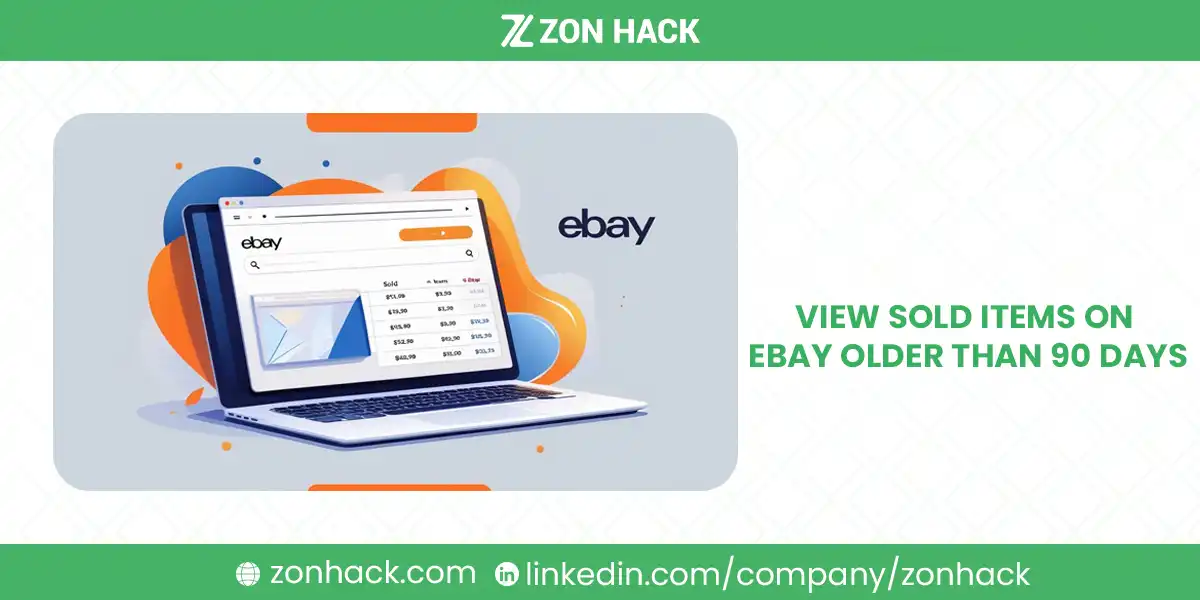If you’ve ever tried to view your eBay sales history beyond 90 days, you’ve likely hit a wall. It’s not a bug—it’s by design.
eBay’s platform, especially its built-in tools like Seller Hub or Listing Analytics, is designed to emphasize recent activity. That means your sold items, transaction history, and buyer insights typically disappear after 90 days.
This cutoff stems from data storage limits, privacy regulations, and the focus on short-term metrics—things like impressions, click-through rate (CTR), and recent conversion data.
While this works for casual sellers or short-cycle items, it’s a major blind spot for those managing eBay sales at scale.
“Sellers analyzing year-over-year trends or seasonal SKUs often struggle when the data is gone before the next cycle even begins.” — ZonHack Strategy Team
If you’re a hybrid seller working across Amazon, eBay, and TikTok Shop (like many ZonHack clients), this limitation makes it hard to spot repeat purchases, map customer retention, or compare platform performance over time.
But there are workarounds—and even some official tools—that let you go beyond the 90-day window.
eBay Tools to View Sold Items Older Than 90 Days (Up to 2 Years)
1. Order History: Now Extends Up to 2 Years
As of 2023, eBay expanded order visibility to 24 months.
You can now access this via:
- Seller Hub → Orders
- My eBay → Sold
Apply filters like:
- This year
- Last year
- Custom date ranges
This is the most direct way to view item-level sales data beyond 90 days—though it’s limited to your fulfilled orders and doesn’t show performance metrics like impressions or CTR.
ZonHack Tip: Export your sold orders monthly as CSV files. Keeping a private archive ensures you always have your full history, even if eBay trims it later.
2. Sales Performance Report
If you’re looking for both metrics and order details, the Sales tab under Performance is your next stop.
Go to: Seller Hub → Performance → Sales
You’ll get:
- Itemized sales by date
- Units sold, prices, and timestamps
- Graphical data (weekly/monthly comparisons)
It’s not perfect for deep historical views, but it’s great for comparing performance across the past 12–24 months.
3. Transaction Reports via Managed Payments
eBay’s shift to Managed Payments also brought better financial reporting tools.
Navigate to:
Seller Hub → Payments → Reports
Here, you’ll find detailed breakdowns of:
- Gross and net revenue
- Shipping, tax, and eBay fees
- Transaction-level history
These reports give a financial lens to your sales—not just what sold, but what it earned you after fees.
This is especially important if you’re reconciling with Amazon payouts, calculating net margin across platforms, or prepping for tax season.
4. Financial Statements (Stored for Up to 10 Years)
Few sellers know this, but eBay retains your monthly financial statements for up to a decade.
Go to:
Reports → Statements
You’ll get:
- Itemized sales summaries
- Monthly income statements
- Net payouts from eBay
These are invaluable when:
- Applying for financing
- Reviewing annual business performance
- Auditing your business over time
ZonHack Insight: Cross-reference your eBay and Amazon monthly statements to understand how each platform contributes to total revenue. It’s a core part of how we build multi-channel dashboards for clients.
5. 1099-K and Tax Invoices
Need official records for accounting or tax filing?
Go to:
Reports → Invoices or Reports → Tax Documents
Look for:
- 1099-K forms (for eligible sellers)
- Tax invoices (with fees and gross amounts)
These won’t show you what items were sold, but they do verify revenue figures—especially important when your books need to line up with what eBay reported to the IRS.
6. Request a Full Data Export from eBay
If you want everything—orders, payouts, preferences, even messages—you can request a complete data export.
Visit: https://www.sarweb.ebay.com/sar
Or navigate to:
- Hi, YourName! → Account Settings
- Personal Info → Request Your eBay Data
eBay will email you when your archive is ready. Expect to wait up to 7 days.
Important Caveat: These reports are detailed but may exclude listing pages, photos, or buyer contact info due to privacy rules.
Historical PayPal Data (If You Sold Before eBay’s Managed Payments)
For sellers who were active on eBay before the Managed Payments transition, some of your older data might still live in PayPal.
This is especially useful if you were operating in 2017–2021, when PayPal handled eBay payments.
To access:
- Go to PayPal.com → Activity → Reports
- Select Activity Download
- Set a custom date range—up to 7 years back
- Export your transactions as CSV files
You’ll find:
- Buyer names
- Transaction dates
- Gross amounts
- Fees
- Notes and messages
While this doesn’t show which items were sold, it helps you verify sales volume, refunds, and total PayPal revenue from eBay activity during that era.
ZonHack Suggestion: Merge PayPal exports with your archived eBay CSVs to recreate older sales cycles and build a year-over-year trend line—essential for forecasting.
Market Research Tools to View Older Sold Listings (Not Your Own Sales)
Sometimes the goal isn’t just to see what you sold—it’s to understand what others are selling, and how the market performed over time. If you’re in wholesale, product research, or cross-platform selling (like eBay + Amazon), then these tools are invaluable.
1. Terapeak Product Research (Built into eBay)
eBay acquired Terapeak and baked it directly into the Seller Hub. You can find it under:
Seller Hub → Research → Terapeak Product Research
It gives access to up to 3 years of eBay-wide sales data, which is well beyond the default 90-day window.
You can search by:
- Keywords
- Categories
- Item condition
- Sale dates
- Listing type (Auction, Buy It Now)
Terapeak tells you:
- Average selling prices
- Sell-through rates
- Seasonal spikes
- Trending keywords
But here’s the caveat: Terapeak doesn’t show your personal sales data. It’s not meant for bookkeeping. Instead, it’s a market analysis tool. Perfect for checking demand before restocking or sourcing a new SKU—especially if you sell the same product on both Amazon and eBay.
ZonHack Tip: Use Terapeak to find underpriced eBay products with high demand and replicate similar listings or bundles on Amazon for profit.
2. Third-Party Tools for Historical Insights
Some sellers need more than raw CSVs or year-over-year performance. If you’re managing multiple platforms or clients (as ZonHack does), you need deeper, long-term insights. Here’s where third-party analytics tools come in.
Putler
Putler is a powerful analytics dashboard for multi-channel sellers (Amazon, eBay, Shopify, WooCommerce).
What makes it valuable?
- Stores unlimited sales history, not just 90 days
- Combines data from all platforms
- Breaks down:
- Customer segmentation
- Repeat purchase rates
- LTV (Lifetime Value)
- Cohort & churn tracking
- Customer segmentation
ZonHack Use Case: Our clients often use Putler to sync Amazon and eBay data in one dashboard, giving them a bird’s-eye view of seasonal trends and performance gaps.
WorthPoint
If you sell collectibles, vintage, or rare goods, WorthPoint is worth exploring. It claims to have 15+ years of historical sales data from eBay and other marketplaces.
It’s not an analytics dashboard like Putler—but it’s excellent for:
- Appraising older items
- Finding pricing history for discontinued SKUs
- Understanding long-term value trends
This is especially useful for antique resellers, estate sale specialists, or brands buying older inventory in bulk.
Best Practices for ZonHack Sellers Using eBay
Whether you’re a seller scaling on your own—or an agency like ZonHack managing multiple accounts—long-term visibility is crucial.
Here’s how we recommend handling the 90-day limit and building better data hygiene habits:
1. Download Monthly Order Reports
Set a monthly reminder to download:
- Order History (CSV) from Seller Hub
- Transaction Reports
- PayPal Activity (if pre-Managed Payments)
This will give you a rolling archive of all sold items, fees, shipping charges, and more.
2. Use Terapeak Regularly
Even though it doesn’t show your data, Terapeak helps you validate demand—especially when deciding whether to restock or pivot away from certain products.
Cross-reference Amazon trends with Terapeak for smarter buying decisions.
3. Sync to a Dashboard Like Putler
If you’re selling on both Amazon and eBay, the smartest move is to sync everything into one dashboard.
This helps with:
- Cross-channel trend analysis
- Tracking repeat buyers
- Comparing eBay seasonality vs. Amazon sales
ZonHack helps build automated reporting systems for our clients using tools like Putler, Data Studio, or custom dashboards depending on the seller’s tech stack.
Final Thoughts from ZonHack
eBay may restrict you to 90 days of visible sales by default, but that doesn’t mean you’re stuck. Between eBay’s own extended tools and a few strategic third-party platforms, you can build a much deeper historical view of your business.
At ZonHack, we work with sellers who need more than just data—they need insight.
We don’t just track your numbers. We help turn them into decisions:
- Should you restock that SKU?
- Is eBay outperforming Amazon this quarter?
- What’s your average customer LTV over 12 months?
Those are the answers ZonHack systems are built to deliver.




